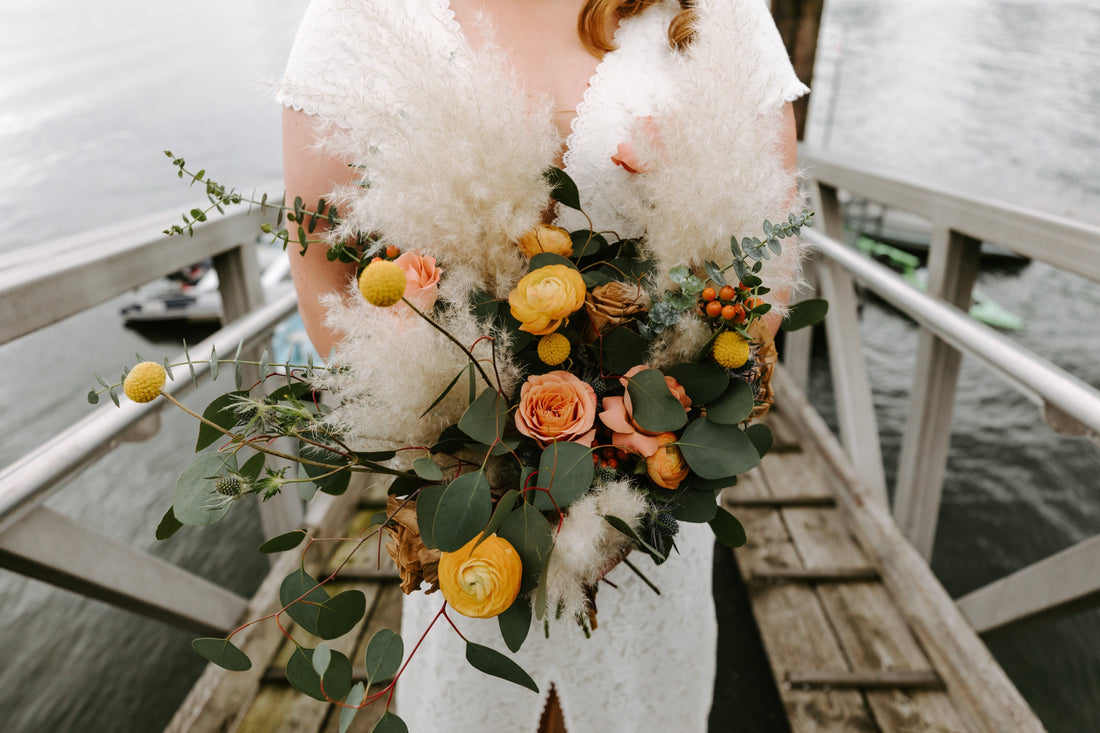
The Ultimate Guide to Wedding Bouquets & Floral Arrangements
Your wedding flowers set the tone for your big day, adding beauty, romance, and personality to your celebration. BUT I know choosing the perfect florals can feel overwhelming with so many options to consider. From the style of your bouquet to the arrangements that will transform your venue, every detail plays a part in creating the atmosphere you’ve been dreaming of. The good news? You don’t have to figure it out alone! Here’s a guide to help you navigate the world of wedding florals with ease and confidence.
The first step in your floral journey is defining your wedding style. Are you envisioning something soft and romantic with cascading blooms, or do you lean towards a modern and minimalist look with sleek, editorial arrangements? Perhaps you love the idea of a classic and elegant affair filled with timeless florals. Whatever your vision, your flowers should reflect the overall aesthetic of your wedding day. Start by gathering inspiration—Pinterest boards, wedding magazines, or even flowers you’ve always loved. And remember, your florist is your creative partner in this process; they can bring your vision to life in ways you may not have even considered.
One of the most exciting floral decisions is choosing your bridal bouquet. This is more than just a bundle of flowers—it’s an extension of your personality and a piece of your wedding story. Consider the shape and size that will complement your dress and personal style. A lush, cascading bouquet makes a dramatic statement, while a smaller, delicate arrangement offers an understated elegance. If you want to add a personal touch, think about including sentimental elements like a family heirloom, a ribbon from your mother’s wedding dress, or a charm with special meaning to you. And don’t forget about practicality—you’ll be holding your bouquet for much of the day, so it should be comfortable and not too heavy!
Your wedding party florals should compliment your bouquet without overshadowing it. Bridesmaids often carry smaller, simpler versions of the bride’s bouquet, while groomsmen sport coordinating boutonnieres. But don’t feel limited to tradition! Flower crowns, corsages, or even floral hoops can add a unique touch. I like to consider how these florals will look in photos to add to the overall wedding aesthetic.
Beyond the bouquets, your ceremony flowers will set the stage for the moment you say “I do.” Whether you opt for a dramatic floral arch, lush aisle arrangements, or something simple like delicate petals lining the walkway, these elements create a breathtaking backdrop for your vows. I always recommend making sure that your ceremony backdrop isn’t completely blocked when you stand in front of it! Consider angles and measurements when choosing the shape or a backdrop and where you’ll be positioned in front of it. Make sure it is positioned to draw eyes and attention to YOU and your partner! Can I share a tip? Repurpose these florals for the reception… altar arrangements can double as head table décor, and aisle florals can be used to decorate guest tables. It’s a beautiful way to maximize your floral budget while keeping everything cohesive. Speaking of the reception, this is where florals truly shine! From stunning centerpieces to delicate accents on the cake table, flowers add warmth and elegance to the space. When planning your reception florals, consider the overall layout—low arrangements allow for easy conversation, while tall centerpieces create a dramatic effect without blocking guests' views. A floral runner along the head table adds romance, and small floral accents on signage, the bar, or even the cake itself bring everything together beautifully.

A great example of a modern take on classic whites. Photo by Simone and Tomaz Weddings
Budget is always a consideration when planning wedding flowers, and one of the best ways to stay within your budget is to focus on seasonal blooms. Not only do they look fresher, but they are also more affordable than out-of-season flowers that have to be imported. For example, peonies and lilacs are gorgeous in spring, dahlias and sunflowers thrive in summer, ranunculus and chrysanthemums shine in fall, and anemones and pine greenery add charm in winter. If your dream flower isn’t in season, your florist can recommend stunning alternatives that achieve the same look.
As you finalize your floral plans, keep a few key tips in mind. Book your florist early—at least 6 to 12 months in advance—especially if you’re getting married during peak wedding season. Be clear about your budget from the start so your florist can help you make the most of it. And most importantly, trust the process! A great florist will take your ideas and elevate them, creating something even more beautiful than you imagined.
Your wedding flowers are more than just decoration—they tell a story, set the mood, and create lasting memories. With thoughtful planning and a little creativity, your floral arrangements will be a breathtaking part of your special day. If you’re ready to bring your vision to life, let’s chat! I’d love to help you design the wedding flowers of your dreams.
